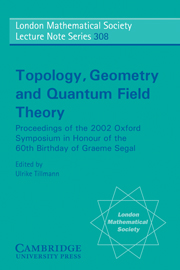 Topology, Geometry and Quantum Field Theory
Topology, Geometry and Quantum Field Theory Book contents
- Frontmatter
- Contents
- Preface
- Participants
- Introduction
- Part I Contributions
- 1 A variant of K-theory: K±
- 2 Two-vector bundles and forms of elliptic cohomology
- 3 Geometric realization of the Segal–Sugawara construction
- 4 Differential isomorphism and equivalence of algebraic varieties
- 5 A polarized view of string topology
- 6 Random matrices and Calabi–Yau geometry
- 7 A survey of the topological properties of symplectomorphism groups
- 8 K-theory from a physical perspective
- 9 Heisenberg groups and algebraic topology
- 10 What is an elliptic object?
- 11 Open and closed string field theory interpreted in classical algebraic topology
- 12 K-theory of the moduli space of bundles on a surface and deformations of the Verlinde algebra
- 13 Cohomology of the stable mapping class group
- 14 Conformal field theory in four and six dimensions
- Part II The definition of conformal field theory
- Foreword and postscript
- The definition of CFT
- References
4 - Differential isomorphism and equivalence of algebraic varieties
Published online by Cambridge University Press: 06 November 2009
- Frontmatter
- Contents
- Preface
- Participants
- Introduction
- Part I Contributions
- 1 A variant of K-theory: K±
- 2 Two-vector bundles and forms of elliptic cohomology
- 3 Geometric realization of the Segal–Sugawara construction
- 4 Differential isomorphism and equivalence of algebraic varieties
- 5 A polarized view of string topology
- 6 Random matrices and Calabi–Yau geometry
- 7 A survey of the topological properties of symplectomorphism groups
- 8 K-theory from a physical perspective
- 9 Heisenberg groups and algebraic topology
- 10 What is an elliptic object?
- 11 Open and closed string field theory interpreted in classical algebraic topology
- 12 K-theory of the moduli space of bundles on a surface and deformations of the Verlinde algebra
- 13 Cohomology of the stable mapping class group
- 14 Conformal field theory in four and six dimensions
- Part II The definition of conformal field theory
- Foreword and postscript
- The definition of CFT
- References
Summary
Introduction
Let X be an irreducible complex affine algebraic variety, and let D(X) be the ring of (global, linear, algebraic) differential operators on X (we shall review the definition in Section 2). This ring has a natural filtration (by order of operators) in which the elements of order zero are just the ring (X) of regular functions on X. Thus, if we are given D(X) together with its filtration, we can at once recover the variety X. But now suppose we are given D(X) just as an abstract noncommutative -algebra, without filtration; then it is not clear whether or not we can recover X. We shall call two varieties X and Y differentially isomorphic if D(X) and D(Y) are isomorphic.
The first examples of nonisomorphic varieties with isomorphic rings of differential operators were found by Levasseur, Smith and Stafford (see [LSS] and Section 9 below). These varieties arise in the representation theory of simple Lie algebras; they are still the only examples we know in dimension > 1 (if we exclude products of examples in lower dimensions). For curves, on the other hand, there is now a complete classification up to differential isomorphism; the main purpose of this article is to review that case. The result is very strange. It turns out that for curves, D(X) determines X (up to isomorphism) except in the very special case when X is homeomorphic to the affine line (we call such a curve a framed curve).
- Type
- Chapter
- Information
- Topology, Geometry and Quantum Field TheoryProceedings of the 2002 Oxford Symposium in Honour of the 60th Birthday of Graeme Segal, pp. 98 - 126Publisher: Cambridge University PressPrint publication year: 2004
- 5
- Cited by


